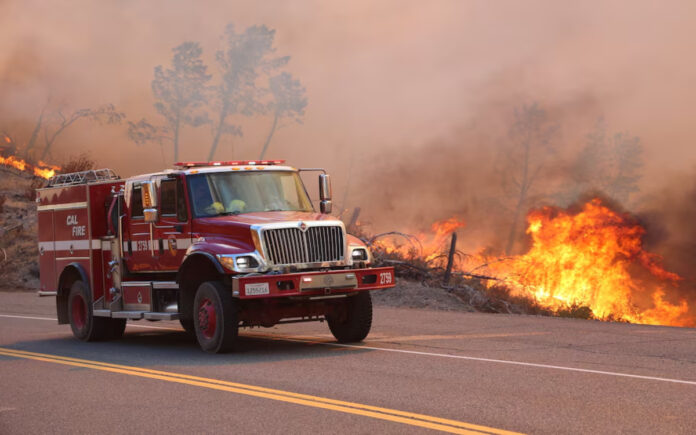Sacramento: In California’s Central Valley, over 6,000 firefighters continued to battle the nation’s largest blaze on Saturday, a fire that has now become the fourth-largest in the state’s history.
Despite thunderstorms on Saturday, the rainfall was minimal—barely reaching one-tenth of an inch—according to forecasters. Temperatures soared to 100 degrees Fahrenheit (38 Celsius), and winds gusted up to 25 mph or more in certain areas, offering little respite to the firefighters working tirelessly to contain the Park Fire. The blaze has been devastating wilderness terrain approximately 100 miles (161 km) north of Sacramento, the state capital.
“We had some thunderstorms that just brought us down-drafts, that’s a problem,” said Christopher Young, a spokesman for the California Department of Forestry and Fire Protection, or Cal Fire. “Lightning is a factor we worry about.”
The Park Fire, which began on July 24 due to an alleged arsonist who pushed a flaming car down a 60-foot gully near Chico, California, has since ravaged more than 400,000 acres (162,200 hectares) or over 600 square miles—an area larger than the city of Los Angeles. The 42-year-old suspect, charged with arson, had not entered a plea as of Saturday and is being held without bail.
Since the fire started 11 days ago, it has destroyed more than 560 homes and other structures, fueled by downed timber, dry grass, and brush. As of Saturday, officials reported that the fire was 27% contained.
Also Read | Britain to Host Key International Investment Summit on October 14
More than 4,000 people have been evacuated, including retiree Jim Young, 65, of Red Bluff, California. Young, who lived in a trailer home with his black Labrador Retriever, Sparky, spent the last eight days camped out with other families in a gravel lot at a wilderness trailhead about six miles from his home.
“We just found out we can go home,” Young told Reuters on Saturday evening. “Our property is safe. So many lost everything. But me and Sparky can go home now.”
Also Read | Middle East Conflict Intensifies as Hezbollah Strikes Israel
The challenging wilderness terrain makes it difficult for firefighters to reach the fire lines, taking two to three hours in some cases. Some firefighters are being transported to the front lines by helicopter, with plans for them to remain there for days, supplied by air.
The national wildfire season has had an intense start, increasing the risk of overextending firefighting resources. The National Interagency Fire Center has already requested assistance from firefighters in Australia and New Zealand, who are set to arrive on August 7 and will be deployed to Oregon and Washington.



